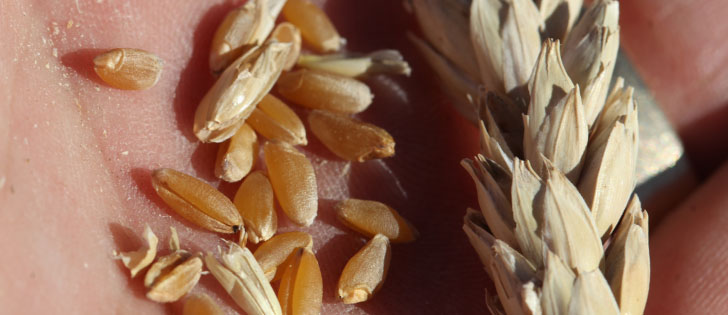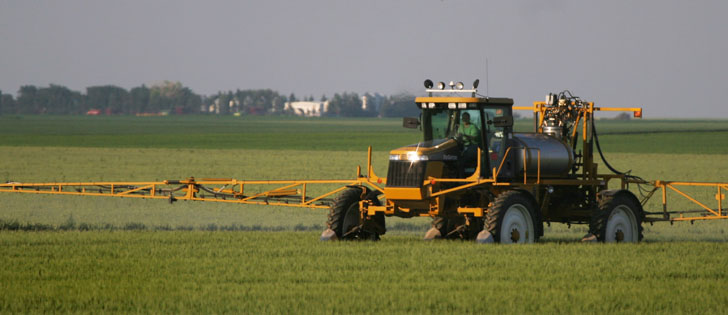It’s often been said that there is nothing certain in life except death and taxes.Western Canadian farmers can add a few other items to that list, such as wild oats in the spring, breakdowns at harvest time and the ongoing debate over optimal row spacing.Guy Lafond, a researcher at Agriculture Canada’s research farm near Indian Head, Sask., says determining the perfect row spacing is difficult because much of the research over the past two or three decades has been conducted at different locations using different methodologies under different growing conditions.“A lot of it is in the details of how you do the research,” said Lafond, one of Western Canada’s foremost experts on the subject.“What you need to do is try and approximate as close as possible what actually happens at the field level.”Lafond has spent a considerable amount of time and effort studying the relationship between row spacing and yield.Other factors that influence row spacing decisions include crop residue and stubble height, fertilizer placement, moisture availability and use and horsepower requirements.Lafond conducted a multi-year study from the late 1980s to the mid-1990s that compared different row spacings in wheat, durum, barley and flax.All crops were planted under the direct seeding system.Using row spacings of four, eight and 12 inches, Lafond’s study suggested that some crops, such as durum, produced consistently higher yields at the widest row spacing, while others, such as flax, appeared to perform better at eight inch intervals.Spring wheat showed little or no yield variability between the eight and 12 inch spacings, based on four years of yield data.Similar studies conducted during the same period by the Prairie Agriculture Machinery Institute (PAMI) assessed wheat, barley and canola yields in a direct seeding system with row spacings of six, eight, 12 and 16 inches.The PAMI studies were conducted from 1993-95 and used test plots in Saskatchewan at Foam Lake, Unity and Naicam.Data from those studies suggested that yields were likely to decrease as row spacings increased, a phenomenon likely attributed to increased weed competition.“At wider row spacing, the crop is less competitive with weeds and it is likely the reduced grain yield at wider row spacings is caused by weed competition,” PAMI said in its research report.As useful as those early projects were, Lafond said a lot has changed in the past 15 years.Advances in fertilizer placement and opener design have allowed a more precise placement of nutrients, so wider spacings are less likely to interfere with germination and cause damage to newly emerged seedlings.“One of the key considerations in determining row spacing is how you manage your fertilizer,” Lafond said.“Is it all placed with the seed or is it side-banded or mid-row banded? If you’re placing all of your fertilizer with the seed, then as you go wider, you can create problems. The fertilizer gets too concentrated.“When we did our initial trials (in the early 1990s), we had no capacity to sideband so we were broadcasting nitrogen ahead of time and putting other (nutrients) down with the seed.… Of course, when we went from the eight inch to the 12 inch spacings, those nutrients just got more concentrated in the row.”Hoping to gain a clearer understanding of the relationship between yield and row spacing, Lafond launched a new study in 2009 that compared oat yields at row spacings of 10, 12, 14 and 16 inches.The trials, all conducted at Indian Head, also used variable nitrogen rates.They are being conducted with a special air drill that allows row spacings to be altered.Seed and fertilizer are placed in two bands with fertilizer located three-quarters of an inch deeper than the seed and 1 1/2 inches to the side of the seed row.The trials have produced only one year of data. Lafond said the study will add to existing knowledge and shed new light on the benefits of wider row spacings.Most farmers in Western Canada use nine or 12 inch spacings, he added.However, some equipment manufacturers have started to promote implements with 14 inch spacings, which Lafond said makes it important to conduct new research into optimal row spacing and its relationship to yield variability and nutrient concentration.He said wider row spacings also reduce the amount of energy required to pull seeding implements and could result in lower fuel costs.“When you sit back and look at the whole context, if you’ve got a machine on nine inch right now and you go to 12 inch, you can pull a wider machine for the same amount of horsepower,” he said.“Because a 33 foot machine with nine inch spacings has 44 openers, so (at 12 inch) you’re increase your seeding capacity by 33 percent for the same effort.“And timeliness (in the spring) is also very important. If you go to wider row spacings, you could go to wider machines and cover more ground.”There is also evidence to suggest that wider row spacings may be preferable in drier soil conditions where higher stubble and minimal soil disturbance is recommended as a way to conserve limited soil moisture.Lafond said trials on the row spacing study will continue for several years and could be expanded to include flax and barley.
Read Also

Equipment manufacturing may return to Canada
Some ag equipment and automotive manufacturers are now adjusting their production and distribution to avoid tariff costs in relation to supplying the Canadian market.















